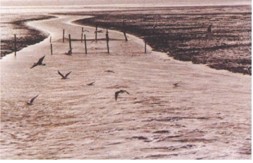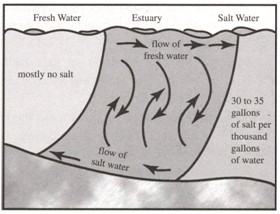人教高中英语高二下UNIT13-2
时间:2018-12-29 作者:英语课 分类:人教高中英语高二

NATURE'S NURSERY: ESTUARIES 1
As the oceans are the source of life on earth, the estuaries are our planet's nurseries. An estuary 2 is the body of water where a river meets the ocean. Salt water from the ocean and fresh water from the river mix together in an estuary. This mixing of fresh and salt water creates a unique environment filled with life of all kinds -- a zone between the land and the sea. Estuaries are the homes of thousands of animals and plants. Many cities and towns are built near estuaries, and a lot offish are caught in estuaries.
Estuaries are great places for nature's young ones. Here, animals can enjoy all the benefits of the oceans without having to face many of the dangers. Tides provide energy for the ecosystems 3, but estuaries are protected from waves and storms by islands, mud or sand. Nutrients 4 arrive in estuaries from both the land and the ocean. The density 5 of living creatures is higher than in any other habitat on earth. The diversity of life in estuaries is incredible -- birds, fish, marine 6 mammals, shellfish and other species all come here to live, feed and reproduce.
Estuaries are also important because they absorb nutrients and pollutants 7 from water coming from inland sources, thus cleaning our water. Unfortunately, this function also makes estuaries very sensitive to environmental pollution. Since estuaries protect animals and plants from storms and floods and prevent erosion, protecting estuaries is very important.
Finally, estuaries provide both recreation and education for human beings. Most of us enjoy fishing, swimming and having fun on the beach, and scientists and students have endless opportunities to study a variety of life in the habitat. Estuaries also contribute to the economy through tourism and fishing. 

- We also recognize the diversity and complexity of controlling in fluences in estuaries. 我们也认识到在河湾内控制影响的多样性和复杂性。
- Estuaries also contribute to economy through tourism and fishing. 河口还为人类提供了休闲和教育的场所。
- We live near the Thames estuary.我们的住处靠近泰晤士河入海口。
- The ship has touched bottom.The estuary must be shallower than we thought.船搁浅了。这河口的水比我们想像的要浅。
- There are highly sensitive and delicately balanced ecosystems in the forest. 森林里有高度敏感、灵敏平衡的各种生态系统。 来自《简明英汉词典》
- Madagascar's ecosystems range from rainforest to semi-desert. 马达加斯加生态系统类型多样,从雨林到半荒漠等不一而足。 来自辞典例句
- a lack of essential nutrients 基本营养的缺乏
- Nutrients are absorbed into the bloodstream. 营养素被吸收进血液。 来自《简明英汉词典》
- The population density of that country is 685 per square mile.那个国家的人口密度为每平方英里685人。
- The region has a very high population density.该地区的人口密度很高。
- Marine creatures are those which live in the sea. 海洋生物是生存在海里的生物。
- When the war broke out,he volunteered for the Marine Corps.战争爆发时,他自愿参加了海军陆战队。
- Pollutants are constantly being released into the atmosphere. 污染物质正在不断地被排放到大气中去。
- The 1987 Amendments limit 301(g) discharges to a few well-studied nonconventional pollutants. 1987年的修正案把第301条(g)的普通排放限制施加在一些认真研究过的几种非常规污染物上。 来自英汉非文学 - 环境法 - 环境法